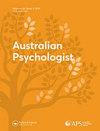Practitioners’ use of exposure therapy in older adults with anxiety disorders
IF 2
4区 心理学
Q2 PSYCHOLOGY, MULTIDISCIPLINARY
引用次数: 0
Abstract
ABSTRACT Objective Despite the empirical support for exposure therapy, it is unclear how many community-dwelling older adults with anxiety disorders receive this intervention. This study examined the use of exposure therapy compared to other treatment techniques among clinicians who treat older adults with anxiety disorders. Method 60 registered mental health treatment providers (e.g., psychologists, clinical psychologists) (M = 44 years, 83.3% female) completed self-report questionnaires assessing the frequency of use of exposure therapy and other treatment techniques for older clients with anxiety disorders, as well as beliefs about the safety and tolerability of exposure for older adults. Results Compared to younger anxious clients, clinicians endorsed significantly less frequent use of exposure therapy than other treatment techniques in older anxious adults. Negative therapist beliefs about the safety and tolerability of exposure therapy were significantly associated with infrequent use of exposure therapy in older adult clients. Clinical qualification was also associated with therapist beliefs about the exposure therapy, with clinicians who hold postgraduate qualifications reporting less negative therapist beliefs about exposure. Conclusions Current findings indicate there may be a need to address negative clinician attitudes towards the use of exposure therapy when working with anxious older clients. KEY POINTS What is already known about this topic: Anxiety disorders are common mental disorders in older adults. Exposure-based cognitive behavioural therapy is highly effective in anxiety treatment. Clinicians trained in exposure therapy rarely deliver exposure therapy or they deliver this therapy in a less effective manner. What this topic adds: Exposure therapy is under-delivered in older adults with anxiety Negative beliefs about exposure therapy are associated with underuse of exposure therapy in older adults. Clinical training should address negative clinician attitudes towards the use of exposure therapy when working with anxious older clients.从业人员使用暴露疗法在老年人焦虑症
摘要目的尽管暴露疗法得到了实证支持,但目前尚不清楚有多少患有焦虑症的社区老年人接受了这种干预。这项研究检查了在治疗患有焦虑症的老年人的临床医生中,暴露疗法与其他治疗技术的使用情况。方法60名注册的心理健康治疗提供者(如心理学家、临床心理学家)(M = 44 年,83.3%的女性)完成了自我报告问卷,评估了对患有焦虑症的老年客户使用暴露疗法和其他治疗技术的频率,以及对老年人暴露的安全性和耐受性的信念。结果与年轻的焦虑症患者相比,临床医生支持在老年焦虑症患者中使用暴露疗法的频率明显低于其他治疗技术。治疗师对暴露治疗的安全性和耐受性的消极信念与老年客户不频繁使用暴露治疗显著相关。临床资格也与治疗师对暴露疗法的信念有关,具有研究生资格的临床医生报告的治疗师对暴露的负面信念较少。结论目前的研究结果表明,在与焦虑的老年客户合作时,可能需要解决临床医生对使用暴露疗法的负面态度。关于这个话题的已知内容:焦虑症是老年人常见的精神障碍。基于暴露的认知行为疗法在焦虑治疗中非常有效。接受过暴露治疗培训的临床医生很少提供暴露治疗,或者他们以一种不太有效的方式提供这种治疗。本主题补充道:暴露治疗在患有焦虑症的老年人中提供不足对暴露治疗的负面信念与暴露治疗在老年人中的使用不足有关。临床培训应解决临床医生在与焦虑的老年客户合作时对使用暴露疗法的负面态度。
本文章由计算机程序翻译,如有差异,请以英文原文为准。
求助全文
约1分钟内获得全文
求助全文
来源期刊

Australian Psychologist
PSYCHOLOGY, MULTIDISCIPLINARY-
CiteScore
3.70
自引率
5.30%
发文量
32
期刊介绍:
The Australian Psychologist is the official applied practice and public policy journal of the Australian Psychological Society. As such, the journal solicits articles covering current issues in psychology, the science and practice of psychology, and psychology"s contribution to public policy, with particular emphasis on the Australian context. Periodically, Australian Psychological Society documents, including but not limited to, position papers, reports of the Society, ethics information, surveys of the membership, announcements, and selected award addresses may appear in the journal.
 求助内容:
求助内容: 应助结果提醒方式:
应助结果提醒方式:


